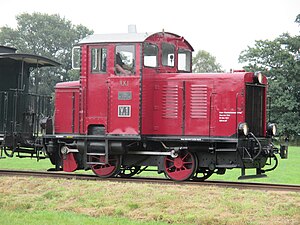Rendsburger Kreisbahn 11
| RK 11 | |
|---|---|
|
DEV V1 in July 2016 in Bruchhausen-Vilsen
|
|
| Numbering: | RK 11; Rendsburger Hafenbahn 1; DEV V1 |
| Number: | 1 |
| Manufacturer: | Croup |
| Year of construction (s): | 1941 |
| Type : | B ie |
| Gauge : | 1000 mm ( meter gauge ) |
| Length over buffers: | 5900 mm |
| Height: | 3640 mm |
| Width: | 2600 mm |
| Fixed wheelbase: | 2000 mm |
| Service mass: | 17.8 t |
| Top speed: | 35 km / h |
| Installed capacity: | 84 kW (114 hp) |
| Driving wheel diameter: | 915 mm |
| Motor type: | MAN W4V 17.5 |
| Motor type: | Four-cylinder diesel |
| Rated speed: | 850 rpm |
| Locomotive brake: | Compressed air: K-PmZ |
The Rendsburger Kreisbahn 11 is a two-axle, meter-gauge diesel locomotive of the Rendsburger Kreisbahn , which is kept operational by the German Railway Association .
history
Due to the Second World War , the traffic on the Rendsburg port railway increased considerably. A locomotive was needed for the shunting. For example, a request for a diesel locomotive was made at Krupp . Krupp offered a machine that was finished except for the paint. Krupp later withdrew the offer that the machine was intended for use abroad. The locomotive could be rented until the end of the war. However, this was not possible due to the lack of fuel on the part of the circular path.
As the transport problems in the port intensified, a new inquiry was made to Krupp in 1943, where nothing stood in the way of a purchase. At Gmeinder in Mosbach, the damage caused to the locomotive by the effects of the war was repaired. The locomotive was accepted on June 6, 1944, although it was too high at 3650 mm at the time. The locomotive was initially rented and bought in October 1945.
The locomotive was mainly used on the port railway between the district station and the Rendsburg transfer station. When meter-gauge operation was discontinued in 1957, locomotive 11 was re-gauged to 1435 mm at Herbert Grabowski in Hamburg. The locomotive was then given the operating number 2 of the Rendsburg port railway, but the letter was RK 1. On April 6, 1973 the deadlines expired and the locomotive was parked. In 1978 the German Railway Association (DEV) acquired the locomotive and assigned it the company number V 1.
In 1979 the locomotive was switched back to meter gauge at Reuschling in Hattingen. In mid-1980 the locomotive could be put back into operation. During a general inspection in 2014, it was largely restored to its delivery condition.
Constructive features
The locomotive has a central driver's cab and the engine is housed in the larger front porch. The jackshaft, which drives the axles via a coupling rod, is located under the rear front end. The rear stem is beveled for better visibility. The locomotive has two driving areas, a shunting and a route aisle.
The engine is a MAN W 4 V 17.5 / 22 A. Power is transmitted by a Krupp adjustable converter fluid transmission according to Lysholm-Smith, which was rather rare at the time. Adjustable blades with which the torque can be changed sit on the drive shaft. The starter is operated by compressed air; one of the engine's cylinders can be switched over to generate energy. Initially, the engine was set to 810 revolutions per minute and developed 80 kW (108 hp). In 1944, the speed was increased to 850 revolutions per minute, with which 84 kW (114 hp) were achieved.
In addition to a balancing lever coupling, the locomotive also had normal pulling and pushing devices so that it could maneuver on the four-rail tracks of the port railway without an intermediate car. The wheels were spoked wheels. The locomotive has a Knorr K-PmZ air brake, and during the narrow-gauge period of the Rendsburg circular railway, the locomotive also had a Körting suction air brake. The locomotive was painted green on the Rendsburger Kreisbahn, on the DEV it has a red body and a black chassis.
